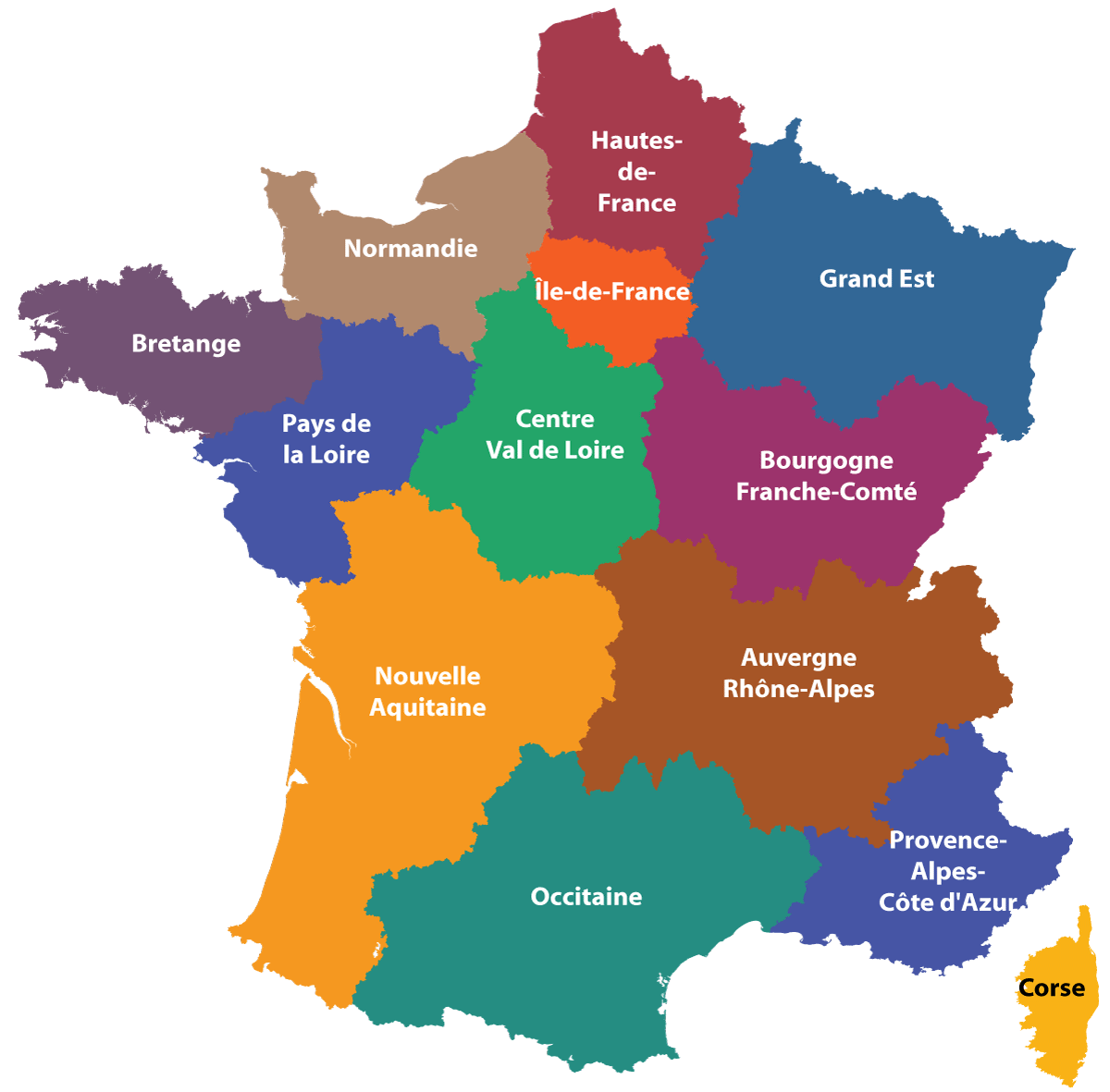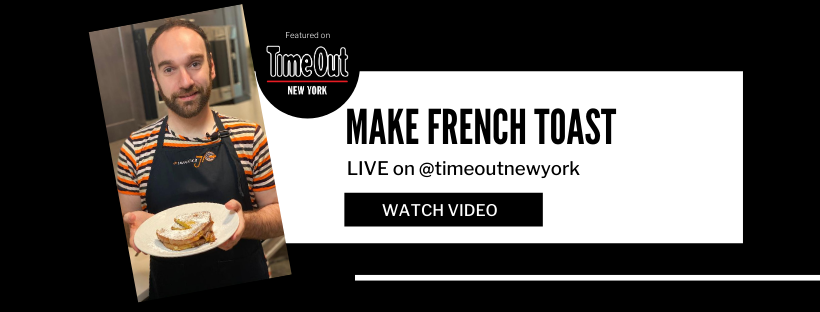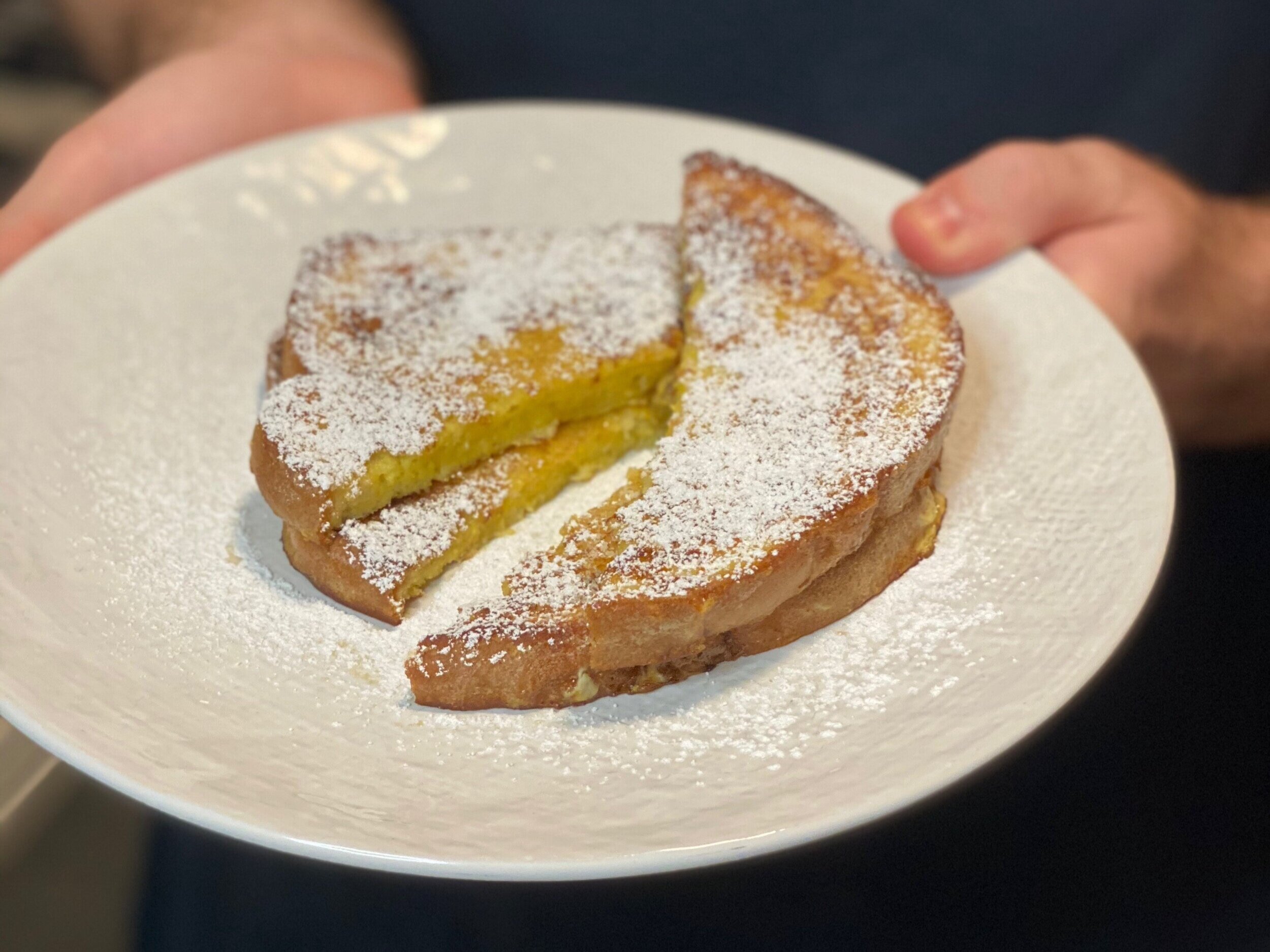
13 Signature Dishes for Each Region of France
Go on a food tour of the regions of Metropolitan France!
by Brian Alcamo
As centralized as the French government is, it still gives some powers to regional authorities. Metropolitan France is home to 13 administrative regions. There used to be 22, but reforms reduced that number down to 13, combining historical regions into larger, modern ones. Many people still identify with their smaller, pre-2015 regions, but we’re modern here at JP Linguistics.
French regions don’t have as much legislative power as US states, but they each have their own cultural specialties, especially when it comes to food. Read on to learn about each of metropolitan France’s 13 regions and a few of their iconic dishes.
A Map of the New 13 Regions of Metropolitan France (since 2015)
Northern France
Hauts-De-France
Hauts-De-France is France’s northernmost region, sharing a border with the sometimes-francophone Belgium. Home to Calais, a major French port city, this region features damp, rainy weather and tons of mussels. When you’re in Hauts-de-France, be sure to grab some moules frites. You won’t be disappointed.
Normandie
Normandy is known for two major exports: apples and Camembert cheese. It's a region that combines seaside culture with the best that Northern France has to offer. Try yourself some moules à la crème normande to get all that Normandy has to offer in one bite. It features local mussels cooked in white wine, garlic, cream, and specialty Norman cider (made from all of those apples).
Île-De-France
Being the political and cultural center of France, Paris and the surrounding Île-De-France region are home to cuisines from all over France and the world. But what about a food native to Île-De-France? Unlike the two other Northern French regions, Île-De-France is landlocked, so seafood is less of a historic culinary staple here. That being said, Île-De-France is known for its deserts. Centuries of entertaining kings and courts means that les sucreries have been well developed here. Try a Paris Brest on your next trip to the capital. It’s a delicate pastry filled will praline cream.
Eastern France
Grand-Est:
The Grand-Est region of France is characterized by its gradient of Germanic culture. The further east you go, the more German the region feels. It should then come as no surprise that the capital city of Strasbourg has a cuisine that competes with its architecture for the most German thing in town. When you’re tired of the Quiche Lorraine, be sure to try some baeckeoffe, a casserole made with potatoes, mutton, beef, pork, and white wine. Astuce: we’re pretty sure this is not vegan friendly.
Bourgogne-Franche Comté
Bourgogne, or Burgundy in English, is well known for its wine. Think: chardonnay and pinot noir. The region is also famous for its mustard, being home to capital city Dijon. If you’re in the area, be sure to try some bœuf bourguignon or coq au vin, depending on your meat of choice. Beef or chicken, both taste delicious when cooked in a local red wine.
Auvergne-Rhône Alpes
Auvergne-Rhone Alpes’ capital city of Lyon is often referred to as the gastronomic capital of the world, which means there’s plenty of good food to go around. If you get tired of the haute-cuisine and experimental restaurants, though, try to grab some tartiflette. This potato-based dish from Savoy features lardons, onions, and Reblochon cheese, all served up in a hot skillet.
(If you’re trying to make tartiflette at home in the US, you’ll have to substitute another cheese for Reblochon. The local delicacy is sadly unavailable in the US because it’s made with unpasteurized milk. Some recommend using delice du jura.)
Central France
Centre-Val de Loire
Centre-Val de Loire is France’s central-most region, and was a hot spot for royals and riches back in the day. This region is characterized by châteaux and nature galore, home to 3 regional parks and the massive Orléans Forest. To get a taste of this region, try some rillettes, a type of confit made from meat, most commonly from braised pork.
Western France
Bretagne
We’ve said it once and we’ll say it again: if you’re in Bretagne you better get yourself a crêpe. It’s the homeland of the crêpe. Get one. If you’re looking to change things up, get it made from buckwheat flour. Afterwards, fix it up with savory fillings and call it a galette.
Nouvelle-Aquitaine
Nouvelle-Aquitaine, a region on the Atlantic coast and home to Bordeaux, is known for its rich cuisine. Foie gras is a local delicacy, and so is anything made with duck, really. Nouvelle-Aquitaine is also where the French Basque country lies. If you want to sample a taste of Basque cuisine, try cooking some piperade or poulet basquaise. You won’t be sorry.
Pays de La Loire
The Pays de La Loire region is known for its seaside cuisine, with the long Loire river bringing fish-able territory far into the region. Nantes, the capital, is famous for its beurre blanc, a sauce that now indispensable to many fish meals in and outside of the region. It’s a sauce made from simple, easy-to-find ingredients: shallots, wine vinegar or white wine, unsalted butter, salt and black pepper. Make your own and drizzle it over the fish of your choosing for a DIY nantais meal.
Southern France
Occitanie
Occitanie, west of Provence, is the southernmost region of mainland France. Its cuisine is influenced by Spain to the south and the wide open Mediterranean sea to the East. When you’re there, be sure to try the cassoulet, a stew made of white beans, lard, pork, and other meats.
Provence-Alpes-Côte d’Azur
This region is known for its Mediterranean flare. If you weren’t hearing French all the time, you might even think you were in Italy. Lighter on the lard and heavier on the herbs, la cuisine provençale will make your mouth water. Yes, you can (and should) indulge in a ratatouille, but what about trying a pan bagnat? It’s a sandwich that can be fixed up with tuna, hard boiled eggs, and whatever vegetables you have lying around. The key here: let the sandwich sit for a bit so that the bread can soak up all the flavors from the ingredients.
Corse
Corse, or Corisca, is an island off the coast of France in the Mediterranean. Its cuisine is even more indicative of the Mediterranean lifestyle and diet than Provence. Expect to find plenty of fish, olives, and citrus. Its cuisine is often more similar to that of Italy than of France. Either way, it’s delicious. For a very-Corsican meal, try eating some pulenda, which is polenta made from chestnut flour. It’s a denser component of the Corsican palate, but will leave you perfectly satiated.
That’s It!
Thanks for reading! Which French region has your favorite cuisine? Comment below, and be sure to share this post with your friends.
(Thumbnail photo by amirali mirhashemian)
The Best and Most Authentic French Toast Recipe - Le Pain Perdu
Learn how to make great Pain Perdu, or French Toast with JP Linguistics. A recipe from a French chef with a South of France touch…
Pain Perdu is a great breakfast or brunch dish that is easy to make, doesn’t ask for much, and taste so good! This French dish, associated with a luxurious and decadent breakfast in America, has not always been so historically. Let’s dive into the history of the French Toast, and look at how to make an authentic Pain Perdu
French Toast or Pain Perdu?
To answer this question, we need to understand the origin of the dish. People have invented le pain (bread) to live a saucy life! Well, in any way, bread is life, we know it. The symbolism attached to bread is deeply anchored in religion making the disposal of bread in the trash, sacrilegious.
To this day, French people have specific ways of treating bread. There's a way to cut bread, with a special knife (couteau à pain), bread cannot be turned on it’s back, and bread should never been thrown in the trash. Bread can be reused to make breadcrumbs (de la chapelure) to be used in other recipes.
But we are degressing. The creation of the wonderful dish is said to come from this one baker, who was not able to sell his bread and the bread became stale. Since he did not want to throw it away and waste a potential income. Instead, the baker developed a recipe based on eggs and milk and turn the stale bread into a delicious treat, giving it’s name or Pain Perdu (lost bread). So, yes, it is a French invention, but it is not a typical toast. There is a reason behind it. So the real name should be Pain Perdu, but let’s be honest, marketing this name would be a little harder…
An Authentic Recipe of Pain Perdu
Inspirée d’une recette par Jean-Pierre Coffe
So let’s see what the hype is all about with this recipe and let’s learn a neat secret ingrédient to make the recette more French.
Ingrédients
25 cl de lait (1 cup of milk);
1 cuillère à soupe d’extrait de fleur d’orangers (1 tablespoon of orange flower water);
50 g de sucre de canne roux deux cuillères à soupe (2 tablespoons of brown sugar) ;
un sachet de sucre vanillé (vanilla sugar or vanilla extract) ;
six tranches de pain blanc (6 slices of white bread);
trois gros œufs entiers (3 large eggs);
25 g de beurre (1/3 cup of butter);
1 pincée de sel fin (1 pinch of salt) ;
confiture ou gelée au choix (marmelade or jam).
Recette (Recipe)
Dans un saladier, ajoutez le lait, le sucre de canne, le sucre vanillé, et l’eau de fleur d’oranger. (Start by adding the milk, the orange flower water, and sugars in a bowl)
Placez les tranches de pain dans un plat creux, mouillez avec le lait sucré, retournez-les pour qu’elles absorbent l’excédent de lait. Laissez reposer pendant quinze minutes. (lay the slices of bread in a hollow dish and pour the sweet milk on the bread, turning them to absorb the excess of milk)
Dans une assiette creuse, battez les œufs en omelette avec la pincée de sel et deux cuillères à soupe de sucre. (in a hollow plate, beat the eggs with a pinch of salt and 2 tablespoons of sugar)
Faites chauffer un peu de beurre dans une poêle sur feu doux. Trempez six tranches de pain dans les œufs battus, déposez-les dans le beurre chaud ; laissez dorer, retournez et faites dorer l’autre face. (Heat a little bit of butter in a pan). Dip each slice of bread in the beaten eggs and place them in the hot butter. Let them get golden and turn them over.)
Servez aussitôt avec les pots de confiture posés sur la table. (serve as soon as possible with your favorite Jam or marmelade)
Option: vous pouvez les saupoudrer de sucres glace. (You can also add confectionner sugar on top of a classy effect).
Bon Appetit!
Let us know how your Pain Perdu turned out! Leave a comment and send us your pictures! Dont forget to tune in on July 14th at 9am for our French Toast demonstration. You can fine the complete line up of events with Time Out New York in this article.
Wrangling With French Wine Consumption
Controversial new guidelines for how much, or little, alcohol one should consume in the country of vin rouge.
France has one of the highest alcohol consumption rates in Europe largely attributed to wine (with just over 50% of the country’s total alcohol consumption). This past Monday, the public health agency and the National Institute of Cancer (INCa) launched a national campaign, with recommendations for the maximum daily intake of alcohol of two glasses per day on non consecutive days. Currently, alcohol is the second-biggest cause for preventable deaths in France after tobacco, killing over 40,000 people each year.
Previously, the daily limit had been set at 2 glasses per day for women and 3 glasses per day for men.
France’s relationship with alcohol has been a long embroiled one as the first-ever campaign to try to get the French to reduce their alcohol consumption in the mid-1950s and encouraged the French to “drink less than a liter of alcohol per meal.” Oddly enough, it wasn’t until 1956 that France banned the serving of alcohol to children under the age of 14 in the school canteens. Prior to that, school children had the right to drink half a liter of wine, cider or beer with their meals. It was only in 1981 that France implemented a total alcohol ban in the country’s schools.
It is safe to say, however, that this recommendation is not going over well with everyone as even France’s Agriculture Minister Didier Guillaume suggested that wine “ isn’t like other alcohols” and rarely the cause of binge drinking amongst the youth. “Alcohol addiction is a real problem, notably among young people with binge drinking and so on,” Guillaume said, blaming the problem rather on hard liquor.
French President Emmanuel Macron similarly found himself a target of criticism last year after telling journalists that he drinks wine with both lunch and dinner and has announced that he had no plans to tighten the laws on alcohol advertising during his presidency.
We hope you’ve enjoyed learning about how the public health agency and the National Institute of Cancer are Wrangling With French Wine Consumption. What are your thoughts on these new recommendations? Join the conversation below!
Financing French Food
You’ve heard of Farm-to-Table, now get ready for “field-to-fork.”
France’s agriculture minister sought to reassure households that food shopping bills would not rise dramatically as an increase in minimum food prices aimed at raising farmers’ incomes came into effect on Friday.
The government had halted the measure in December in the midst of “yellow vest” protests over high living costs. Didier Guillaume, the country’s agriculture minister, noted that prices of goods sold in supermarkets at a discount ( including Nutella, Coca-Cola) would increase a meager 5%. This all comes part of the “field-to-fork” bill introduced by President Emmanuel Macron to win support among farmers regarding their concerns of being hit by low margins and ending up the victims of retail price wars.
Michel-Edouard Leclerc, CEO of supermarket chain Leclerc, has branded the food price increases a “scam” and said farmers would not see higher prices as the chain typically makes a margin of 30-40 percent on farmers’ products.
The new legislation includes a 10% increase in the price floor for food products and curbs promotional offers so that retailers cannot discount products by more than 34% of their value which is said to bring the average household shopping bill to increase by anywhere from 50 cents to 3 euros a month.
We hope you’ve enjoyed learning how customers will be Financing French Food! Do you think this bill is a good measure to protect farmers? Join the conversation below!
Bubbling Over
A fizzy mouth feel begins with a second round of fermentation.
Champagne.
While many know it as a beloved celebratory beverage, it also has deep roots in the region of, you guessed it, Champagne. However, there was a heavy influence in the surge of the bubbly wine brought on by one of France’s greatest trading neighbors: the English.
In reality, the champaign we enjoy today is much like the beverage the English created by mistake. Benedictine monks were supplying them with still wines from Champagne, red and white wines which were left on the London docks during the sub freezing winters. The wines eventually got cold so they started undergoing a second fermentation causing them to become carbonated.
According to popular belief, Champagne was first created in the 17th century by a monk named Dom Pierre Pérignon, but it was English physician Christopher Merret was the first to describe the second fermentation process in wine to create fizz.
One of the byproducts of fermentation is the release of carbon dioxide gas, which is trapped inside the wine, causing intense pressure to build up, and in the 17th century, pressure inside these weak French wine bottles often caused them to explode. Originally, the French were horrified to find their wine containing bubbles, and considered it a fault, but many wine drinkers started becoming accustomed to the bubbly sensation, and soon Champagne gained its popularity worldwide. The English also rediscovered the use of cork stoppers, once used by the Romans but forgotten for centuries after the fall of the Western Roman Empire.
Speaking of corks, you may notice that one of the distinguishing features of champagne is the “muselet” or wire cage fitted over the mouth of a Champagne bottle. This ingenious addition was created in the 19th century to prevent the cork from popping out due to pressure from bubbles.
Though there were ups and downs throughout the history of champagne sales have grown steadily to over 200 million bottles since 1950. The increase in worldwide demand has prompted the French authorities to look into expanding the region's AOC zone to facilitate more production.
We hope you’ve enjoyed seeing how Bubbling Over wine led to the creation of one of the most famous celebratory beverages in the world. How much credit do you believe the English deserve for the creation of champagne? Join the conversation below!
Sampling Goût de France
Celebrating the taste of French cuisine with 3000 chefs worldwide.
Now on it’s 4th year as a tradition, restaurants around the world will be joining forces to celebrate French cuisine by offering French-inspired meals as part of "Goût de France / Good France.”
With 3000 chefs in attendance, Goût de France / Good France aims to unite all types of restaurants from around around the world. The first edition of the international event took place in 2015 soon after UNESCO placed the country’s "Repas gatsronomique des Français" on the World Intangible Heritage list.
Under the program, participating chefs give diners a unique "art de vivre" experience. Each menu will have the opportunity to add diversity to French gastronomy, as chefs are allowed to integrate quality produce from their own country to their menu proposals.
As stated by the official Gout de France website, the goal of the event is to:
"PROMOTE FRENCH TOURISM — in an effort to promote France, this one of a kind diner will take advantage of international visibility, and aim to send a strong message to the world, through dynamic and creative chefs. CARRY THE COLORS OF FRENCH CUISINE WITH PRIDE — it will send messages of strong added values: The message that French cuisine is CONTEMPORARY — Traditional French cuisine is not a dominion of the 21st century culinary scene. Participating chefs are encouraged to blend their own culinary culture to that of France, rather than discounting it. The message that French cuisine is EXCELLENCE — Healthy, Innovative, and Responsible: In addition to representing the heartiness associated with the pleasures of eating, food also becomes the symbol of France’s positive values. Healthy dishes prepared from fresh, seasonal, and local produce, with low fat, salt, and sugar content; Meals for everyone, from bistro to gourmet dining."
Participants can expect quite the dining experience as each guest will have access to:
One traditional French aperitif : champagne and gougeres (stuffed or not) or - iced cognac with foie gras
One cold appetizer
One hot appetizer
One fish or shell-fish based course
One meat or poultry based course
One or a selection of French cheeses
One chocolate dessert
A selection of French wines
One French liqueur
For a full list of restaurants participating in the event, click below!
We hope you have enjoyed about how the world is Sampling Goût de France! Which is your favorite of the menu listings being offered at this delicious yearly event? Leave a comment below!
Burger vs. Baguette
The French have been cheating on their beloved baguette with a saucier culinary import - the hamburger.
It’s no secret that the french are famous for their baguette, especially if you follow our blog! One might even say they are sacred (especially if you ask France's President Emmanuel Macron who is lobbying to have the french delicacy listed as a Unesco cultural treasure). The French government actually regulated when bakers could take their vacations at one point so that its citizens wouldn’t ever be faced with a shortage of their favorite bread. However, a recent study shows that that the French are cheating on their beloved baguette with a much less authentic culinary import - the hamburger.
According to a recent BBC reported study, French citizens purchased approximately 1.5 billion burgers last year and only about 1.2 billion baguettes which equals to 14 times more burgers than a decade ago. The figures include the purchase of baguette sandwiches, known as jambon-beurre. The study also showed that nearly 85% of all restaurants in France now have at least one burger on their menus.
French purists have nothing to fear however as Gira Conseil, who provided the data for the study, says the report has been greatly exaggerated by stating “Let me explain: baguettes are taken away and eaten with fingers, burgers are mostly eaten sitting down with a knife and fork.” “It’s not comparing like with like.” Regardless of the French obsession with the burger, one aspect that will always make it uniquely French is that unlike their American counterparts, the French enjoy their burgers with a fork and knife—a concession even McDonald’s has made in the land of the baguette.
We hope you've enjoyed learning about the culinary French battle: Burger vs. Baguette! While may French are skeptical about the legitimacy of their reported burger obsession, we'd love to hear what you think about the Gira Conseil study. Comment below!























